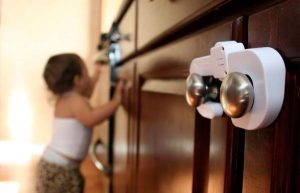 According the organization Safe Kids Worldwide, in the US more than 10,000 children are seen in emergency departments every day for the kinds of injuries that commonly happen at home, and a large number of injury-related deaths also happen at home. These figures are proportionally as high in many other countries. Yikes!
According the organization Safe Kids Worldwide, in the US more than 10,000 children are seen in emergency departments every day for the kinds of injuries that commonly happen at home, and a large number of injury-related deaths also happen at home. These figures are proportionally as high in many other countries. Yikes!
Now that we’ve thoroughly scared you, here’s the good news: These injuries are preventable if you set aside a few hours to babyproof your home. It is highly recommended to do this before your baby learns to crawl, but you might want to consider doing it before she is born.
Browse Our Child Safety Online Classes
Highlights:
|
Let’s take a look at the top babyproofing advice from child development experts:
Baby Equipment
All baby equipment, like cribs, high-chairs, changing tables, and car seats should meet the U.S. Consumer Product Safety Commission’s safety standards, which you can find here along with other information like baby item safety recalls.
Keep baby’s crib bare (just a tight-fitting sheet). Bumpers, blankets, pillows and stuffed animals are suffocation hazards.
Furniture
Secure pieces like dressers, bookshelves and entertainment centers to the wall. These can tip over if children climb on them.
Cover sharp corners on coffee tables, end tables, fireplaces and the like with adhesive corner-guards. Little ones newly on the move or climbing on furniture are apt to bump into or fall on these.
Stairs
Block stairs with gates. It’s important to put gates at the bottom of the stairs, too; little ones learn how to crawl up before they learn how to crawl safely back down.
Appliances
Secure TVs to the wall. They can fall easily if pushed or grabbed.
Put child locks on stove knobs so baby can’t turn on the burners when she learns to stand. Also put a child lock on the oven door so she can’t open it while it’s hot.
Put any electrical cords that hang low into a wall-mounted cord holder, or bundle them and attach them to the wall with electrical tape. Babies may accidentally wrap these around their neck or pull an appliance down from a shelf.
Cover all wall outlets with outlet covers to prevent baby from sticking a finger or other object inside.
Windows & Doors
Be sure all windows and doors have child locks on them to prevent falls, or baby going down into the basement or out into the street.
Put any cords dangling from window coverings out of baby’s reach. Like appliance cords, she may play with these and wrap them around her neck.
Cabinets & Drawers
Put cleaning products, medication, alcohol, spices, hygiene or beauty products, or any other substance that could be dangerous if swallowed or inhaled in a high cabinet out of baby’s reach. Plastic bags should be out of baby’s reach, too, as they are a suffocation risk.
Install child locks on cabinets or drawers within baby’s reach (especially in the kitchen) to avoid accidents with knives, eating or cooking utensils, glass dishes and the like.
Toilets, Bathtubs & Pools
Little ones can drown in seconds in just inches of water (including the toilet). Secure your toilet seat with a child lock, and monitor baby at all times while she’s in the tub.
Be sure your pool is surrounded by a pool fence with a child-proof lock.
Electronics
Keep electronics with batteries out of baby’s reach to avoid her taking the batteries out (especially the small, button type) and putting them in her mouth.
Toys
Check baby’s toys for any small parts that she could swallow or choke on.
Houseplants
It’s a good idea to keep plants out of baby’s reach, simply to avoid a mess! Some plants, though, are also hazardous if swallowed. In the U.S., you can call the Poison Control Center (1-800-222-1222) for a list of hazardous plants.
Emergency Information
Post emergency phone numbers in a central location and point them out to anyone who stays with your baby. Include the Poison Control Center, your pediatrician, your phone number, and alternate in-case-of-emergency phone numbers of family or close friends.
Being free to explore and play is crucial to all areas of your baby’s development. Monitoring your baby is the best thing you can do to keep her safe, but let’s face it, the older they get the faster they are! Babyproofing is an easy way to avoid preventable accidents while your tot is on the go around the house.
Back







